Liverpool F.C.
 | ||||
| Full name | Liverpool Football Club | |||
|---|---|---|---|---|
| Nickname(s) | The Reds | |||
| Short name | LFC | |||
| Founded | 3 June 1892[1] | |||
| Ground | Anfield | |||
| Capacity | 54,074[2] | |||
| Owner | Fenway Sports Group | |||
| Chairman | Tom Werner | |||
| Manager | Jürgen Klopp | |||
| League | Premier League | |||
| 2017–18 | Premier League, 4th of 20 | |||
| Website | Club website | |||
|
| ||||
Liverpool Football Club is a professional football club in Liverpool, England, that competes in the Premier League, the top tier of English football. The club has won 5 European Cups, more than any other English club, 3 UEFA Cups, 3 UEFA Super Cups, 18 League titles, 7 FA Cups, 8 League Cups, and 15 FA Community Shields.
Founded in 1892, the club joined the Football League the following year and has played at Anfield since its formation. Liverpool established itself as a major force in English and European football in the 1970s and 1980s when Bill Shankly and Bob Paisley led the club to 11 League titles and seven European trophies. Under the management of Rafael Benítez and captained by Steven Gerrard, Liverpool became European champions for the fifth time in 2005.
Liverpool was the ninth highest-earning football club in the world in 2016–17, with an annual revenue of €424.2 million,[3] and the world's eighth most valuable football club in 2018, valued at $1.944 billion.[4] The club is one of the best supported teams in the world.[5] Liverpool has long-standing rivalries with Manchester United and Everton.
The club's supporters have been involved in two major tragedies: the Heysel Stadium disaster, where escaping fans were pressed against a collapsing wall at the 1985 European Cup Final in Brussels, with 39 people – mostly Italians and Juventus fans – dying, after which English clubs were given a five-year ban from European competition, and the Hillsborough disaster in 1989, where 96 Liverpool supporters died in a crush against perimeter fencing.
The team changed from red shirts and white shorts to an all-red home strip in 1964 which has been used ever since. The club's anthem is "You'll Never Walk Alone".
History
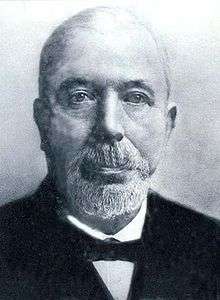
Liverpool F.C. was founded following a dispute between the Everton committee and John Houlding, club president and owner of the land at Anfield. After eight years at the stadium, Everton relocated to Goodison Park in 1892 and Houlding founded Liverpool F.C. to play at Anfield.[6] Originally named "Everton F.C. and Athletic Grounds Ltd" (Everton Athletic for short), the club became Liverpool F.C. in March 1892 and gained official recognition three months later, after The Football Association refused to recognise the club as Everton.[7] The team won the Lancashire League in its début season, and joined the Football League Second Division at the start of the 1893–94 season. After finishing in first place the club was promoted to the First Division, which it won in 1901 and again in 1906.[8]
Liverpool reached its first FA Cup Final in 1914, losing 1–0 to Burnley. It won consecutive League championships in 1922 and 1923, but did not win another trophy until the 1946–47 season, when the club won the First Division for a fifth time under the control of ex-West Ham Utd centre half George Kay.[9] Liverpool suffered its second Cup Final defeat in 1950, playing against Arsenal.[10] The club was relegated to the Second Division in the 1953–54 season.[11] Soon after Liverpool lost 2–1 to non-league Worcester City in the 1958–59 FA Cup, Bill Shankly was appointed manager. Upon his arrival he released 24 players and converted a boot storage room at Anfield into a room where the coaches could discuss strategy; here, Shankly and other "Boot Room" members Joe Fagan, Reuben Bennett, and Bob Paisley began reshaping the team.[12]
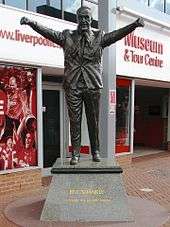
The club was promoted back into the First Division in 1962 and won it in 1964, for the first time in 17 years. In 1965, the club won its first FA Cup. In 1966, the club won the First Division but lost to Borussia Dortmund in the European Cup Winners' Cup final.[13] Liverpool won both the League and the UEFA Cup during the 1972–73 season, and the FA Cup again a year later. Shankly retired soon afterwards and was replaced by his assistant, Bob Paisley.[14] In 1976, Paisley's second season as manager, the club won another League and UEFA Cup double. The following season, the club retained the League title and won the European Cup for the first time, but it lost in the 1977 FA Cup Final. Liverpool retained the European Cup in 1978 and regained the First Division title in 1979.[15] During Paisley's nine seasons as manager Liverpool won 21 trophies, including three European Cups, a UEFA Cup, six League titles and three consecutive League Cups; the only domestic trophy he did not win was the FA Cup.[16]
Paisley retired in 1983 and was replaced by his assistant, Joe Fagan.[17] Liverpool won the League, League Cup and European Cup in Fagan's first season, becoming the first English side to win three trophies in a season.[18] Liverpool reached the European Cup final again in 1985, against Juventus at the Heysel Stadium. Before kick-off, Liverpool fans breached a fence which separated the two groups of supporters, and charged the Juventus fans. The resulting weight of people caused a retaining wall to collapse, killing 39 fans, mostly Italians. The incident became known as the Heysel Stadium disaster. The match was played in spite of protests by both managers, and Liverpool lost 1–0 to Juventus. As a result of the tragedy, English clubs were banned from participating in European competition for five years; Liverpool received a ten-year ban, which was later reduced to six years. Fourteen Liverpool fans received convictions for involuntary manslaughter.[19]
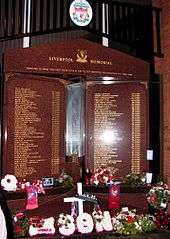
Fagan had announced his retirement just before the disaster and Kenny Dalglish was appointed as player-manager.[20] During his tenure, the club won another three league titles and two FA Cups, including a League and Cup "Double" in the 1985–86 season. Liverpool's success was overshadowed by the Hillsborough disaster: in an FA Cup semi-final against Nottingham Forest on 15 April 1989, hundreds of Liverpool fans were crushed against perimeter fencing.[21] Ninety-four fans died that day; the 95th victim died in hospital from his injuries four days later and the 96th died nearly four years later, without regaining consciousness.[22] After the Hillsborough disaster there was a government review of stadium safety. The resulting Taylor Report paved the way for legislation that required top-division teams to have all-seater stadiums. The report ruled that the main reason for the disaster was overcrowding due to a failure of police control.[23]
Liverpool was involved in the closest finish to a league season during the 1988–89 season. Liverpool finished equal with Arsenal on both points and goal difference, but lost the title on total goals scored when Arsenal scored the final goal in the last minute of the season.[24]
Dalglish cited the Hillsborough disaster and its repercussions as the reason for his resignation in 1991; he was replaced by former player Graeme Souness.[25] Under his leadership Liverpool won the 1992 FA Cup Final, but their league performances slumped, with two consecutive sixth-place finishes, eventually resulting in his dismissal in January 1994. Souness was replaced by Roy Evans, and Liverpool went on to win the 1995 Football League Cup Final. While they made some title challenges under Evans, third-place finishes in 1996 and 1998 were the best they could manage, and so Gérard Houllier was appointed co-manager in the 1998–99 season, and became the sole manager in November 1998 after Evans resigned.[26] In 2001, Houllier's second full season in charge, Liverpool won a "Treble": the FA Cup, League Cup and UEFA Cup.[27] Houllier underwent major heart surgery during the 2001–02 season and Liverpool finished second in the League, behind Arsenal.[28] They won a further League Cup in 2003, but failed to mount a title challenge in the two seasons that followed.
.jpg)
Houllier was replaced by Rafael Benítez at the end of the 2003–04 season. Despite finishing fifth in Benítez's first season, Liverpool won the 2004–05 UEFA Champions League, beating A.C. Milan 3–2 in a penalty shootout after the match ended with a score of 3–3.[29] The following season, Liverpool finished third in the Premier League and won the 2006 FA Cup Final, beating West Ham United in a penalty shootout after the match finished 3–3.[30] American businessmen George Gillett and Tom Hicks became the owners of the club during the 2006–07 season, in a deal which valued the club and its outstanding debts at £218.9 million.[31] The club reached the 2007 UEFA Champions League Final against Milan, as it had in 2005, but lost 2–1.[32] During the 2008–09 season Liverpool achieved 86 points, its highest Premier League points total, and finished as runners up to Manchester United.[33]
In the 2009–10 season, Liverpool finished seventh in the Premier League and failed to qualify for the Champions League. Benítez subsequently left by mutual consent[34] and was replaced by Fulham manager Roy Hodgson.[35] At the start of the 2010–11 season Liverpool was on the verge of bankruptcy and the club's creditors asked the High Court to allow the sale of the club, overruling the wishes of Hicks and Gillett. John W. Henry, owner of the Boston Red Sox and of Fenway Sports Group, bid successfully for the club and took ownership in October 2010.[36] Poor results during the start of that season led to Hodgson leaving the club by mutual consent and former player and manager Kenny Dalglish taking over.[37] In the 2011–12 season, Liverpool secured a record 8th League Cup success and reached the FA Cup final, but finished in eighth position, the worst league finish in 18 years; this led to the sacking of Dalglish.[38][39] He was replaced by Brendan Rodgers,[40] whose Liverpool team in the 2013–14 season mounted an unexpected title charge to finish second behind champions Manchester City and subsequently return to the Champions League, scoring 101 goals in the process, the most since the 106 scored in the 1895–96 season.[41][42] Following a disappointing 2014–15 season, where Liverpool finished sixth in the league, and a poor start to the following campaign, Rodgers was sacked in October 2015.[43] He was replaced by Jürgen Klopp,[44] who in his first season at Liverpool, took the club to the finals of both the Football League Cup and UEFA Europa League, finishing as runner-up in both competitions.[45]
Colours and badge
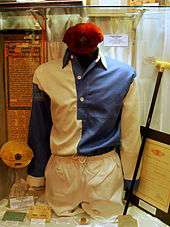
For much of Liverpool's history its home colours have been all red, but when the club was founded its kit was more like the contemporary Everton kit. The blue and white quartered shirts were used until 1894, when the club adopted the city's colour of red.[6] The city's symbol of the liver bird was adopted as the club's badge in 1901, although it was not incorporated into the kit until 1955. Liverpool continued to wear red shirts and white shorts until 1964, when manager Bill Shankly decided to change to an all red strip.[46] Liverpool played in all red for the first time against Anderlecht, as Ian St. John recalled in his autobiography:
-
He [Shankly] thought the colour scheme would carry psychological impact – red for danger, red for power. He came into the dressing room one day and threw a pair of red shorts to Ronnie Yeats. "Get into those shorts and let's see how you look", he said. "Christ, Ronnie, you look awesome, terrifying. You look 7 ft tall." "Why not go the whole hog, boss?" I suggested. "Why not wear red socks? Let's go out all in red." Shankly approved and an iconic kit was born.[47]
The Liverpool away strip has more often than not been all yellow or white shirts and black shorts, but there have been several exceptions. An all grey kit was introduced in 1987, which was used until the 1991–92 centenary season, when it was replaced by a combination of green shirts and white shorts. After various colour combinations in the 1990s, including gold and navy, bright yellow, black and grey, and ecru, the club alternated between yellow and white away kits until the 2008–09 season, when it re-introduced the grey kit. A third kit is designed for European away matches, though it is also worn in domestic away matches on occasions when the current away kit clashes with a team's home kit. Between 2012–15, the kits were designed by Warrior Sports, who became the club's kit providers at the start of the 2012–13 season.[48] In February 2015, Warrior's parent company New Balance announced it would be entering the global football market, with teams sponsored by Warrior now being outfitted by New Balance.[49] The only other branded shirts worn by the club were made by Umbro until 1985, when they were replaced by Adidas, who produced the kits until 1996 when Reebok took over. They produced the kits for 10 years before Adidas made the kits from 2006 to 2012.[50]
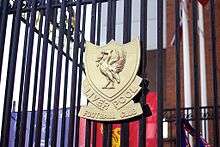
Liverpool was the first English professional club to have a sponsor's logo on its shirts, after agreeing a deal with Hitachi in 1979.[51] Since then the club has been sponsored by Crown Paints, Candy, Carlsberg and Standard Chartered Bank. The contract with Carlsberg, which was signed in 1992, was the longest-lasting agreement in English top-flight football.[52] The association with Carlsberg ended at the start of the 2010–11 season, when Standard Chartered Bank became the club's sponsor.[53]
The Liverpool badge is based on the city's liver bird, which in the past had been placed inside a shield. In 1992, to commemorate the centennial of the club, a new badge was commissioned, including a representation of the Shankly Gates. The next year twin flames were added at either side, symbolic of the Hillsborough memorial outside Anfield, where an eternal flame burns in memory of those who died in the Hillsborough disaster.[54] In 2012, Warrior Sports' first Liverpool kit removed the shield and gates, returning the badge to what had adorned Liverpool shirts in the 1970s; the flames were moved to the back collar of the shirt, surrounding the number 96 for the number who died at Hillsborough.[55]
Stadium
.jpg)
Anfield was built in 1884 on land adjacent to Stanley Park. It was originally used by Everton before the club moved to Goodison Park after a dispute over rent with Anfield owner John Houlding.[56] Left with an empty ground, Houlding founded Liverpool in 1892 and the club has played at Anfield ever since. The capacity of the stadium at the time was 20,000, although only 100 spectators attended Liverpool's first match at Anfield.[57]
The Kop was built in 1906 due to the high turnout for matches and was called the Oakfield Road Embankment initially. Its first game was on 1 September 1906 when the home side beat Stoke City 1–0.[58] In 1906 the banked stand at one end of the ground was formally renamed the Spion Kop after a hill in KwaZulu-Natal.[59] The hill was the site of the Battle of Spion Kop in the Second Boer War, where over 300 men of the Lancashire Regiment died, many of them from Liverpool.[60] At its peak, the stand could hold 28,000 spectators and was one of the largest single-tier stands in the world. Many stadia in England had stands named after Spion Kop, but Anfield's was the largest of them at the time; it could hold more supporters than some entire football grounds.[61]
Anfield could accommodate more than 60,000 supporters at its peak, and had a capacity of 55,000 until the 1990s. The Taylor Report and Premier League regulations obliged Liverpool to convert Anfield to an all-seater stadium in time for the 1993–94 season, reducing the capacity to 45,276.[62] The findings of the Taylor Report precipitated the redevelopment of the Kemlyn Road Stand, which was rebuilt in 1992, coinciding with the centenary of the club, and was known as the Centenary Stand until 2017 when it was renamed the Kenny Dalglish Stand. An extra tier was added to the Anfield Road end in 1998, which further increased the capacity of the ground but gave rise to problems when it was opened. A series of support poles and stanchions were inserted to give extra stability to the top tier of the stand after movement of the tier was reported at the start of the 1999–2000 season.[63]
Because of restrictions on expanding the capacity at Anfield, Liverpool announced plans to move to the proposed Stanley Park Stadium in May 2002.[64] Planning permission was granted in July 2004,[65] and in September 2006, Liverpool City Council agreed to grant Liverpool a 999-year lease on the proposed site.[66] Following the takeover of the club by George Gillett and Tom Hicks in February 2007, the proposed stadium was redesigned. The new design was approved by the Council in November 2007. The stadium was scheduled to open in August 2011 and would hold 60,000 spectators, with HKS, Inc. contracted to build the stadium.[67] Construction was halted in August 2008, as Gillett and Hicks had difficulty in financing the £300 million needed for the development.[68] In October 2012, BBC Sport reported that Fenway Sports Group, the new owners of Liverpool FC, had decided to redevelop their current home at Anfield stadium, rather than building a new stadium in Stanley Park. As part of the redevelopment the capacity of Anfield was to increase from 45,276 to approximately 60,000 and would cost approximately £150m.[69] When construction was completed on the new Main stand the capacity of Anfield was increased to 54,074. This £100 million expansion added a third tier to the stand. This was all part of a £260 million project to improve the Anfield area. Jurgen Klopp the manager at the time described the stand as "impressive."[70]
Support
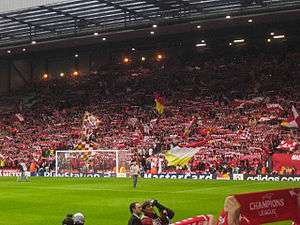
Liverpool is one of the best supported clubs in the world.[5][71] The club states that its worldwide fan base includes more than 200 officially recognised Club of the LFC Official Supporters Clubs in at least 50 countries. Notable groups include Spirit of Shankly.[72] The club takes advantage of this support through its worldwide summer tours,[73] which has included playing in front of 101,000 in Michigan, U.S., and 95,000 in Melbourne, Australia.[74][75] Liverpool fans often refer to themselves as Kopites, a reference to the fans who once stood, and now sit, on the Kop at Anfield.[76] In 2008 a group of fans decided to form a splinter club, A.F.C. Liverpool, to play matches for fans who had been priced out of watching Premier League football.[77]
The song "You'll Never Walk Alone", originally from the Rodgers and Hammerstein musical Carousel and later recorded by Liverpool musicians Gerry and the Pacemakers, is the club's anthem and has been sung by the Anfield crowd since the early 1960s.[78] It has since gained popularity among fans of other clubs around the world.[79] The song's title adorns the top of the Shankly Gates, which were unveiled on 2 August 1982 in memory of former manager Bill Shankly. The "You'll Never Walk Alone" portion of the Shankly Gates is also reproduced on the club's crest.[80]
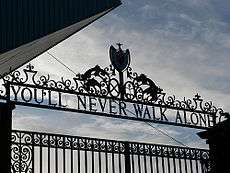
The club's supporters have been involved in two stadium disasters. The first was the 1985 Heysel Stadium disaster, in which 39 Juventus supporters were killed. They were confined to a corner by Liverpool fans who had charged in their direction; the weight of the cornered fans caused a wall to collapse. UEFA laid the blame for the incident solely on the Liverpool supporters,[81] and banned all English clubs from European competition for five years. Liverpool was banned for an additional year, preventing it from participating in the 1990–91 European Cup, even though it won the League in 1990.[82] Twenty-seven fans were arrested on suspicion of manslaughter and were extradited to Belgium in 1987 to face trial.[83] In 1989, after a five-month trial in Belgium, 14 Liverpool fans were given three-year sentences for involuntary manslaughter;[84] half of the terms were suspended.[85]
The second disaster took place during an FA Cup semi-final between Liverpool and Nottingham Forest at Hillsborough Stadium, Sheffield, on 15 April 1989. Ninety-six Liverpool fans died as a consequence of overcrowding at the Leppings Lane end, in what became known as the Hillsborough disaster. In the following days The Sun newspaper published an article entitled "The Truth", in which it claimed that Liverpool fans had robbed the dead and had urinated on and attacked the police.[86] Subsequent investigations proved the allegations false, leading to a boycott of the newspaper by Liverpool fans across the city and elsewhere; many still refuse to buy The Sun more than 20 years later.[87] Many support organisations were set up in the wake of the disaster, such as the Hillsborough Justice Campaign, which represents bereaved families, survivors and supporters in their efforts to secure justice.[88]
Rivalries
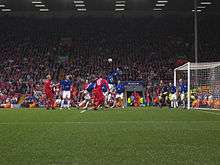
Liverpool's longest-established rivalry is with fellow Liverpool team Everton, against whom they contest the Merseyside derby. The rivalry stems from Liverpool's formation and the dispute with Everton officials and the then owners of Anfield.[89] The Merseyside derby is one of the few local derbies which do not enforce fan segregation, and hence has been known as the "friendly derby".[90] Since the mid-1980s, the rivalry has intensified both on and off the field and, since the inception of the Premier League in 1992, the Merseyside derby has had more players sent off than any other Premier League game. It has been referred to as "the most ill-disciplined and explosive fixture in the Premier League".[91]
Liverpool's rivalry with Manchester United stems from the cities' competition in the Industrial Revolution of the 19th century.[92] The two clubs alternated as champions between 1964 and 1967,[93] and Manchester United became the first English team to win the European Cup in 1968, followed by Liverpool's four European Cup victories.[94] Despite the 38 league titles and eight European Cups between them[93] the two rivals have rarely been successful at the same time – Liverpool's run of titles in the 1970s and 1980s coincided with Manchester United's 26-year title drought, and United's success in the Premier League-era has likewise coincided with Liverpool's ongoing drought,[95] and the two clubs have finished first and second in the league only five times.[93] Nonetheless, former Manchester United manager Alex Ferguson said in 2002, "My greatest challenge was knocking Liverpool right off their fucking perch",[96] and the last player to be transferred between the two clubs was Phil Chisnall, who moved to Liverpool from Manchester United in 1964.[97]
Ownership and finances
.jpg)
As the owner of Anfield and founder of Liverpool, John Houlding was the club's first chairman, a position he held from its founding in 1892 until 1904. John McKenna took over as chairman after Houlding's departure.[98] McKenna subsequently became President of the Football League.[99] The chairmanship changed hands many times before John Smith, whose father was a shareholder of the club, took up the role in 1973. He oversaw the most successful period in Liverpool's history before stepping down in 1990.[100] His successor was Noel White who became chairman in 1990.[101] In August 1991 David Moores, whose family had owned the club for more than 50 years became chairman. His uncle John Moores was also a shareholder at Liverpool and was chairman of Everton from 1961 to 1973. Moores owned 51 percent of the club, and in 2004 expressed his willingness to consider a bid for his shares in Liverpool.[102]
Moores eventually sold the club to American businessmen George Gillett and Tom Hicks on 6 February 2007. The deal valued the club and its outstanding debts at £218.9 million. The pair paid £5,000 per share, or £174.1m for the total shareholding and £44.8m to cover the club's debts.[103] Disagreements between Gillett and Hicks, and the fans' lack of support for them, resulted in the pair looking to sell the club.[104] Martin Broughton was appointed chairman of the club on 16 April 2010 to oversee its sale.[105] In May 2010, accounts were released showing the holding company of the club to be £350m in debt (due to leveraged takeover) with losses of £55m, causing auditor KPMG to qualify its audit opinion.[106] The group's creditors, including the Royal Bank of Scotland, took Gillett and Hicks to court to force them to allow the board to proceed with the sale of the club, the major asset of the holding company. A High Court judge, Mr Justice Floyd, ruled in favour of the creditors and paved the way for the sale of the club to Fenway Sports Group (formerly New England Sports Ventures), although Gillett and Hicks still had the option to appeal.[107] Liverpool was sold to Fenway Sports Group on 15 October 2010 for £300m.[108]
Liverpool has been described as a global brand; a 2010 report valued the club's trademarks and associated intellectual property at £141m, an increase of £5m on the previous year. Liverpool was given a brand rating of AA (Very Strong).[109] In April 2010 business magazine Forbes ranked Liverpool as the sixth most valuable football team in the world, behind Manchester United, Real Madrid, Arsenal, Barcelona and Bayern Munich; they valued the club at $822m (£532m), excluding debt.[110] Accountants Deloitte ranked Liverpool eighth in the Deloitte Football Money League, which ranks the world's football clubs in terms of revenue. Liverpool's income in the 2009–10 season was €225.3m.[111]
Liverpool in popular culture
Because of its successful history, Liverpool is often featured when football is depicted in British culture and has appeared in a number of media firsts. The club appeared in the first edition of the BBC's Match of the Day, which screened highlights of its match against Arsenal at Anfield on 22 August 1964. The first football match to be televised in colour was between Liverpool and West Ham United, broadcast live in March 1967.[112] Liverpool fans featured in the Pink Floyd song "Fearless", in which they sang excerpts from "You'll Never Walk Alone".[113] To mark the club's appearance in the 1988 FA Cup Final, Liverpool released a song known as the "Anfield Rap", featuring John Barnes and other members of the squad.[114]
A documentary drama on the Hillsborough disaster, written by Jimmy McGovern, was screened in 1996. It featured Christopher Eccleston as Trevor Hicks, whose story is the focus of the script. Hicks, who lost two teenage daughters in the disaster, went on to campaign for safer stadiums and helped to form the Hillsborough Families Support Group.[115] Liverpool featured in the film The 51st State (also known as Formula 51), in which ex-hitman Felix DeSouza (Robert Carlyle) is a keen supporter of the team and the last scene takes place at a match between Liverpool and Manchester United.[116] The club was featured in a children's television show called Scully; the plot revolved around a young boy, Francis Scully, who tried to gain a trial match with Liverpool. The show featured prominent Liverpool players of the time such as Kenny Dalglish.[117]
Players
First-team squad
- As of 30 August 2018[118]
Note: Flags indicate national team as defined under FIFA eligibility rules. Players may hold more than one non-FIFA nationality.
|
|
Out on loan
Note: Flags indicate national team as defined under FIFA eligibility rules. Players may hold more than one non-FIFA nationality.
|
|
Reserves and Academy
Former players
Player records
Club captains
Since the establishment of the club in 1892, 45 players have been club captain of Liverpool F.C.[133] Andrew Hannah became the first captain of the club after Liverpool separated from Everton and formed its own club. Initially Alex Raisbeck, who was club captain from 1899 to 1909, was the longest serving captain before being overtaken by Steven Gerrard who served 12 seasons as Liverpool captain starting from the 2003–04 season.[133] The present captain is Jordan Henderson, who replaced Gerrard in the 2015–16 season following Gerrard's move to LA Galaxy.[134][135]
Player of the Season
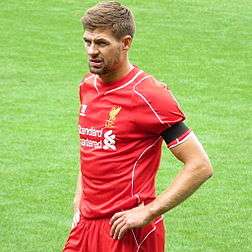
.jpg)
| Season | Name | Nationality | Position | Notes | Ref. |
|---|---|---|---|---|---|
| 2001–02 | Sami Hyypiä | Defender | [136] | ||
| 2002–03 | Danny Murphy | Midfielder | [137] | ||
| 2003–04 | Steven Gerrard | Midfielder | [138] | ||
| 2004–05 | Jamie Carragher | Defender | Steven Gerrard was also chosen by the fans as their Player of the Season | [139] | |
| 2005–06 | Steven Gerrard (2) | Midfielder | Also won PFA Players' Player of the Year | [140] | |
| 2006–07 | Steven Gerrard (3) | Midfielder | [141] | ||
| 2007–08 | Fernando Torres | Forward | [142] | ||
| 2008–09 | Steven Gerrard (4) | Midfielder | Also won FWA Footballer of the Year | [143] | |
| 2009–10 | Pepe Reina | Goalkeeper | [144] | ||
| 2010–11 | Lucas Leiva | Midfielder | [145] | ||
| 2011–12 | Martin Škrtel | Defender | [146] | ||
| 2012–13 | Luis Suárez | Forward | [147] | ||
| 2013–14 | Luis Suárez (2) | Forward | Also won PFA Players' Player of the Year, Premier League Player of the Season and FWA Footballer of the Year | [148] | |
| 2014–15 | Philippe Coutinho | Midfielder | [149] | ||
| 2015–16 | Philippe Coutinho (2) | Midfielder | [150] | ||
| 2016–17 | Sadio Mané | Forward | [151] | ||
| 2017–18 | Mohamed Salah | Forward | Also won PFA Players' Player of the Year, PFA Fans' Player of the Year, Premier League Player of the Season and FWA Footballer of the Year | [152] |
Club officials
|
|
Honours
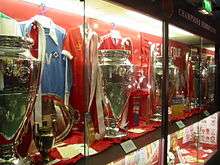
Liverpool's first trophy was the Lancashire League, which it won in the club's first season.[161] In 1901, the club won its first League title, while its first success in the FA Cup was in 1965. In terms of the number of trophies won, Liverpool's most successful decade was the 1980s, when the club won six League titles, two FA Cups, four League Cups, five Charity Shields (one shared) and two European Cups.
The club has accumulated more top-flight wins and points than any other English team.[162] Liverpool also has the highest average league finishing position (3.3) for the 50-year period to 2015[163] and second-highest average league finishing position for the period 1900–1999 after Arsenal, with an average league placing of 8.7.[164] Liverpool has won the European Cup, UEFA's premier club competition, five times, an English record and only surpassed by Real Madrid and Milan. Liverpool's fifth European Cup win, in 2005, meant that the club was awarded the trophy permanently and was also awarded a multiple-winner badge.[165][166] Liverpool also hold the English record of three wins in the UEFA Cup, UEFA's secondary club competition.[167]
Domestic
League
Cups
- FA Cup
- Football League Cup
- FA Charity / Community Shield
- Sheriff of London Charity Shield
- Winners (1): 1906
- Football League Super Cup
- Winners (1): 1985–86
European
Doubles and Trebles
- Doubles:[note 1]
- League and FA Cup: 1
- League and League Cup: 2
- European Double (League and European Cup): 1
- League and UEFA Cup: 2
- League Cup and European Cup: 1
- Trebles[note 1]
- League, League Cup and European Cup: 1
- FA Cup, League Cup and UEFA Cup: 1
Especially short competitions, such as the FA Community Shield and the UEFA Super Cup, are not generally considered to contribute towards a Double or Treble.[168]
Notes
Footnotes
Citations
- ↑ "Happy birthday LFC? Not quite yet..." Liverpool F.C. Retrieved 15 March 2014.
Liverpool F.C. was born on 3 June 1892. It was at John Houlding's house in Anfield Road that he and his closest friends left from Everton FC, formed a new club.
- ↑ "New Anfield capacity confirmed as 54,074". Retrieved 9 September 2016.
- ↑ "Deloitte Football Money League 2018". Deloitte. 23 January 2018. Retrieved 23 January 2018.
- ↑ Ozanian, Mike. "The World's Most Valuable Soccer Teams 2018". Forbes. Retrieved 2018-06-12.
- 1 2 "How Liverpool's worldwide fanbase will be tuning into events at Manchester United". Liverpool Echo. Retrieved 29 July 2018.
- 1 2 "Liverpool Football Club is formed". Liverpool F.C. Archived from the original on 12 July 2010. Retrieved 11 August 2010.
- ↑ Graham 1985, p. 14.
- ↑ Graham 1985, pp. 16–18.
- ↑ Graham 1985, p. 20.
- ↑ Liversedge 1991, p. 14.
- ↑ Kelly 1988, pp. 50–51.
- ↑ Kelly 1988, p. 57.
- ↑ "1965/66: Stan the man for Dortmund". Union of European Football Associations (UEFA). Archived from the original on 10 May 2014.
- ↑ Kelly 1999, p. 86.
- ↑ Pead 1986, p. 414.
- ↑ Kelly 1988, p. 157.
- ↑ Kelly 1988, p. 158.
- ↑ Cox, Russell & Vamplew 2002, p. 90.
- ↑ "On This Day – 29 May 1985: Fans die in Heysel rioting". BBC. 29 May 1985. Retrieved 12 September 2006.
- ↑ Kelly 1988, p. 172.
- ↑ "On This Day – 15 April 1989: Soccer fans crushed at Hillsborough". BBC. 15 April 1989. Retrieved 12 September 2006.
- ↑ Pithers, Malcolm (22 December 1993). "Hillsborough victim died 'accidentally': Coroner says withdrawal of treatment not to blame". The Independent. Retrieved 28 August 2010.
- ↑ "A hard lesson to learn". BBC. 15 April 1999. Retrieved 12 September 2006.
- ↑ Cowley, Jason (29 March 2009). "The night Football was reborn". The Observer. Retrieved 23 July 2011.
- ↑ Liversedge 1991, pp. 104–105.
- ↑ Kelly (1999). The Boot Room Boys: Inside the Anfield Boot Room. p. 227.
- ↑ "Houllier acclaims Euro triumph". BBC Sport. 16 May 2001. Retrieved 24 March 2007.
- ↑ "Houllier 'satisfactory' after surgery". BBC Sport. 15 October 2001. Retrieved 13 March 2007.
- ↑ "AC Milan 3–3 Liverpool (aet)". BBC Sport. 25 May 2005. Retrieved 15 April 2007.
- ↑ "Liverpool 3–3 West Ham (aet)". BBC Sport. 13 May 2006. Retrieved 26 August 2010.
- ↑ "US pair agree Liverpool takeover". BBC Sport. 6 February 2007. Retrieved 2 March 2007.
- ↑ McNulty, Phil (23 May 2007). "AC Milan 2–1 Liverpool". BBC Sport. Retrieved 23 May 2007.
- ↑ "Liverpool's top-flight record". LFC History. Retrieved 19 August 2011.
- ↑ "Rafael Benitez leaves Liverpool: club statement". The Daily Telegraph. 3 June 2010. Retrieved 3 June 2010.
- ↑ "Liverpool appoint Hodgson". Liverpool F.C. 1 July 2010. Archived from the original on 29 July 2010. Retrieved 11 August 2010.
- ↑ Gibson, Owen (15 October 2010). "Liverpool FC finally has a new owner after 'win on penalties'". The Guardian. Retrieved 7 November 2010.
- ↑ "Roy Hodgson exits and Kenny Dalglish takes over". BBC Sport. 8 January 2011. Retrieved 22 April 2011.
- ↑ Bensch, Bob; Panja, Tariq (16 May 2012). "Liverpool Fires Dalglish After Worst League Finish in 18 Years". Bloomberg. Archived from the original on 20 June 2012.
- ↑ Ingham, Mike (16 May 2012). "Kenny Dalglish sacked as Liverpool manager". BBC. Retrieved 10 June 2012.
- ↑ "Liverpool manager Brendan Rodgers to 'fight for his life'". BBC. 1 June 2012. Retrieved 10 June 2012.
- ↑ Ornstein, David (12 May 2014). "Liverpool: Premier League near-miss offers hope for the future". BBC Sport. BBC. Retrieved 7 August 2014.
- ↑ "Goals". Liverpool F.C. Archived from the original on 13 August 2012. Retrieved 27 August 2012.
- ↑ "Brendan Rodgers: Liverpool boss sacked after Merseyside derby". BBC Sport. 4 October 2015. Retrieved 10 October 2015.
- ↑ Smith, Ben (8 October 2015). "Liverpool: Jurgen Klopp confirmed as manager on £15m Anfield deal". BBC Sport. BBC. Retrieved 10 October 2015.
- ↑ "Liverpool 1–3 Sevilla". BBC. 18 May 2016.
- 1 2 "Historical LFC Kits". Liverpool F.C. Archived from the original on 24 July 2010. Retrieved 12 August 2010.
- ↑ St. John, Ian (9 October 2005). "Shankly: the hero who let me down". The Times. Retrieved 12 September 2006.
- ↑ "LFC and Warrior announcement". Archived from the original on 20 January 2012. Retrieved 18 January 2012.
- ↑ Badenhausen, Kurt (4 February 2015). "New Balance Challenges Nike And Adidas With Entry into Global Soccer Market". Forbes. Retrieved 4 February 2015.
- ↑ Crilly 2007, p. 28.
- ↑ Dart, James; Tinklin, Mark (6 July 2005). "Has a streaker ever scored?". The Guardian. Retrieved 16 August 2007.
- ↑ Espinoza, Javier (8 May 2009). "Carlsberg and Liverpool might part ways". Forbes. Retrieved 23 July 2008.
- ↑ "Liverpool and Standard Chartered announce sponsorship deal". Standard Chartered Bank. 14 September 2009. Retrieved 12 August 2010.
- ↑ "Hillsborough". Liverpool F.C. Retrieved 12 August 2010.
- ↑ "Liverpool kit launch sparks anger among Hillsborough families". BBC Sport. BBC. 11 May 2012. Retrieved 17 May 2012.
- ↑ Liversedge 1991, p. 112.
- ↑ Kelly 1988, p. 187.
- ↑ Moynihan, Leo. The pocket book of Liverpool. p. 24.
- ↑ Liversedge 1991, p. 113.
- ↑ Kelly 1988, p. 188.
- ↑ Pearce, James (23 August 2006). "How Kop tuned into glory days". Liverpool Echo. Archived from the original on 10 February 2009. Retrieved 6 December 2008.
- ↑ "Club Directory". Premier League Handbook Season 2010/11 (PDF). Premier League. 2010. p. 35. Archived from the original (PDF) on 14 December 2010. Retrieved 17 August 2010.
- ↑ "Anfield". Liverpool F.C. Retrieved 15 August 2010.
- ↑ "Liverpool unveil new stadium". BBC Sport. 17 May 2002. Retrieved 17 March 2007.
- ↑ Hornby, Mike (31 July 2004). "Reds stadium gets go-ahead". Liverpool Echo. Retrieved 12 September 2006.
- ↑ "Liverpool get go-ahead on stadium". BBC Sport. 8 September 2006. Retrieved 8 March 2007.
- ↑ "Liverpool's stadium move granted". BBC. 6 November 2007. Retrieved 22 August 2010.
- ↑ "Liverpool stadium 'will be built'". BBC Sport. 17 September 2009. Retrieved 28 July 2011.
- ↑ Smith, Ben (15 October 2012). "Liverpool to redevelop Anfield instead of building on Stanley Park". BBC Sport. BBC. Retrieved 16 August 2014.
- ↑ "Liverpool's new Main Stand boosts Anfield capacity to 54,000".
- ↑ Rice, Simon (6 November 2009). "Manchester United top of the 25 best supported clubs in Europe". The Independent. Retrieved 6 August 2011.
- ↑ "LFC Official Supporters Clubs". Liverpool F.C. Archived from the original on 23 July 2011. Retrieved 6 August 2011.
- ↑ "Asia Tour 2011". Liverpool F.C. 27 July 2011. Archived from the original on 11 July 2015. Retrieved 2 September 2014.
- ↑ "Steven Gerrard delights the MCG crowd as Liverpool beats Melbourne Victory 2-0". ABC. Retrieved 29 July 2018.
- ↑ "Man Utd 1-4 Liverpool: Xherdan Shaqiri scores stunning overhead kick". BBC. Retrieved 29 July 2018.
- ↑ "Anfield giants never walk alone". Fédération Internationale de Football Association (FIFA). 11 June 2008. Archived from the original on 11 September 2008. Retrieved 14 November 2008.
- ↑ George, Ricky (18 March 2008). "Liverpool fans form a club in their price range". The Daily Telegraph. Retrieved 18 March 2008.
- ↑ Hart, Simon (25 October 2013). "Anfield's 50 years of never walking alone". The Independent. Retrieved 20 July 2018.
- ↑ "Liverpool". Fédération Internationale de Football Association (FIFA). Retrieved 23 July 2011.
- ↑ "LFC Crests". Liverpool F.C. Retrieved 29 July 2018.
- ↑ McKie, David (31 May 1985). "Thatcher set to demand FA ban on games in Europe". The Guardian. Retrieved 7 December 2008.
- ↑ "The Heysel disaster". BBC. 29 May 2000. Retrieved 7 December 2008.
- ↑ "1987: Liverpool fans to stand trial in Belgium". BBC. 9 September 1987. Retrieved 22 August 2010.
- ↑ Jackson, Jamie (4 April 2005). "The witnesses". The Guardian. Retrieved 27 May 2006.
- ↑ "Liverpool remembers Heysel". BBC. 29 May 2000. Retrieved 24 May 2006.
- ↑ Smith, David (11 July 2004). "The city that eclipsed the Sun". The Guardian. Retrieved 7 December 2008.
- ↑ Burrell, Ian (8 July 2004). "An own goal? Rooney caught in crossfire between 'The Sun' and an unforgiving city". The Independent. Retrieved 22 December 2008.
- ↑ "Hillsbrough Family Support Group". Liverpool F.C. Archived from the original on 3 February 2012. Retrieved 23 July 2011.
- ↑ "Classic: Everton-Liverpool". Fédération Internationale de Football Association (FIFA). 11 September 2006. Archived from the original on 25 August 2009. Retrieved 20 December 2008.
- ↑ Smith, Rory (24 January 2009). "Liverpool and Everton no longer play the 'friendly derby' as fans become more vitriolic". The Daily Telegraph. Retrieved 26 August 2010.
- ↑ Smith, Rory (7 February 2010). "Liverpool 1 Everton 0: match report". The Daily Telegraph. Retrieved 20 July 2011.
- ↑ Rohrer, Finlo (21 August 2007). "Scouse v Manc". BBC. Retrieved 3 April 2008.
- 1 2 3 Cox, Michael (12 December 2014). "Man Utd vs. Liverpool is close to a classic rivalry, but lacks major drama". ESPN FC.
- ↑ "Liverpool VS Manchester United: Red rivalry on England's north-west". FIFA.com. Retrieved 3 February 2015.
- ↑ Jolly, Richard (13 December 2014). "Manchester United – Liverpool remains English football's No.1 rivalry". Goal.com.
- ↑ Taylor, Daniel (9 January 2011). "The greatest challenge of Sir Alex Ferguson's career is almost over". The Guardian.
- ↑ Ingle, Sean; Murray, Scott (10 May 2000). "Knowledge Unlimited". The Guardian. Retrieved 26 February 2008.
- ↑ Liversedge 1991, p. 108.
- ↑ Liversedge 1991, p. 109.
- ↑ Liversedge 1991, p. 110.
- ↑ Reade 2009, p. 206.
- ↑ Narayana, Nagesh (5 March 2008). "Factbox Soccer who owns Liverpool Football Club". Reuters. Retrieved 22 August 2010.
- ↑ Wilson, Bill (6 February 2007). "US business duo at Liverpool helm". BBC. Retrieved 2 December 2008.
- ↑ McNulty, Phil (20 January 2008). "Liverpool braced for takeover bid". BBC Sport. Retrieved 2 December 2008.
- ↑ Bandini, Paolo (16 April 2010). "Liverpool appoint Martin Broughton as chairman to oversee sale of club". The Guardian. Retrieved 16 April 2010.
- ↑ Conn, David (7 May 2010). "Auditors cast doubt on future of Liverpool after losses". The Guardian. Retrieved 8 May 2010.
- ↑ "Liverpool takeover to go ahead as owners lose case". ESPN. 13 October 2010. Retrieved 23 March 2011.
- ↑ "Liverpool takeover completed by US company NESV". BBC Sport. 15 October 2010. Retrieved 12 August 2011.
- ↑ "Top 25 Football Club Brands" (PDF). Brand Finance. Retrieved 7 August 2011.
- ↑ "Liverpool". Forbes. 21 April 2010. Retrieved 8 August 2010.
- ↑ Wilson, Bill (10 February 2011). "Real Madrid top football rich list for sixth year". BBC. Retrieved 22 July 2011.
- ↑ Kelly 1988, p. 192.
- ↑ "The Hillsborough Tragedy". BBC. 16 June 2000. Retrieved 23 December 2008.
- ↑ "Footballer Barnes for rap return". BBC. 3 March 2006. Retrieved 2 December 2008.
- ↑ "Hillsborough's Sad Legacy". BBC. 14 April 1999. Retrieved 23 December 2008.
- ↑ Ebert, Roger (18 October 2002). "Formula 51". Chicago Sun-Times. Retrieved 19 August 2011.
- ↑ "Scully". BBC. 20 August 2009. Retrieved 19 August 2011.
- 1 2 "First team". Liverpool F.C. Retrieved 30 August 2018.
- ↑ Shaw, Chris (10 August 2015). "Milner on vice-captain honour and Coutinho class". Liverpool F.C. Retrieved 20 July 2018.
- ↑ "Henderson appointed Liverpool captain". Liverpool F.C. 10 July 2015. Retrieved 18 July 2018.
- ↑ Shaw, Chris (25 August 2018). "Loris Karius joins Besiktas on two-year loan". Liverpool F.C. Retrieved 25 August 2018.
- ↑ Williams, Sam (19 August 2018). "Grujic signs new LFC deal and joins Hertha BSC on loan". Liverpool F.C. Retrieved 23 August 2018.
- ↑ Carroll, James (9 August 2018). "Danny Ings completes move to Southampton". Liverpool F.C. Retrieved 10 August 2018.
- ↑ "Adam Bogdan joins Hibernian on loan". Liverpool F.C. 2 July 2018. Retrieved 20 July 2018.
- ↑ Lynch, David (22 July 2018). "Ryan Kent makes Rangers loan switch". Liverpool F.C. Retrieved 22 July 2018.
- ↑ Lynch, David (7 June 2018). "Ejaria signs new LFC deal, joins Rangers on loan". Liverpool F.C. Retrieved 20 July 2018.
- ↑ Carroll, James (30 August 2018). "Sheyi Ojo signs new deal and makes loan move". Liverpool F.C. Retrieved 30 August 2018.
- ↑ Williams, Sam (23 August 2018). "Randall joins Rochdale on loan". Liverpool F.C. Retrieved 23 August 2018.
- ↑ Carroll, James (1 August 2018). "Ben Woodburn joins Sheffield United on loan". Liverpool F.C. Retrieved 1 August 2018.
- ↑ Shaw, Chris (17 July 2018). "Harry Wilson joins Derby on season-long loan". Liverpool F.C. Retrieved 20 July 2018.
- ↑ Carroll, James (25 July 2018). "Allan signs new deal and joins Frankfurt on loan". Liverpool F.C. Retrieved 25 July 2018.
- ↑ Carroll, James (23 July 2018). "Taiwo Awoniyi seals loan switch to KAA Gent". Liverpool F.C. Retrieved 23 July 2018.
- 1 2 "Captains for Liverpool FC since 1892". Liverpool F.C. 29 April 2009. Archived from the original on 18 July 2009. Retrieved 14 February 2015.
- ↑ "Henderson appointed new Liverpool Captain". 10 July 2015. Retrieved 10 July 2015.
- ↑ "Steven Gerrard: LA Galaxy confirm deal for Liverpool captain". BBC Sport. 7 January 2015. Retrieved 25 August 2015.
- ↑ Eaton, Paul (13 May 2002). "We speak to YOUR Player of the Season". Liverpool F.C. Archived from the original on 12 June 2015. Retrieved 4 June 2015.
- ↑ Eaton, Paul (7 May 2003). "Murphy named Reds Player of the Season". Liverpool F.C. Archived from the original on 14 July 2015. Retrieved 4 June 2015.
- ↑ "Gerrard delighted with Player of the Year vote". Liverpool F.C. 21 May 2004. Archived from the original on 12 June 2015. Retrieved 4 June 2015.
- ↑ Hunter, Steve (4 May 2005). "Carra wins .tv player of the season". Liverpool F.C. Archived from the original on 14 July 2015. Retrieved 4 June 2015.
- ↑ Rogers, Paul (23 May 2006). "It's Official: LFC Player of the Season". Liverpool F.C. Archived from the original on 12 June 2015. Retrieved 4 June 2015.
- ↑ "Gerrard voted fans' player of the season". Liverpool F.C. 26 May 2007. Archived from the original on 12 June 2015. Retrieved 4 June 2015.
- ↑ Eaton, Paul (19 May 2008). "Vote result: LFC Player of the Season". Liverpool F.C. Archived from the original on 12 June 2015. Retrieved 4 June 2015.
- ↑ Carroll, James (4 June 2009). "LFC Player of the Season: Steven Gerrard". Liverpool F.C. Archived from the original on 12 June 2015. Retrieved 4 June 2015.
- ↑ Rice, Jimmy (11 May 2010). "Reina crowned Player of 09–10". Liverpool F.C. Archived from the original on 23 April 2014. Retrieved 4 June 2015.
- ↑ Carroll, James (24 May 2011). "Lucas scoops 2010–11 award". Liverpool F.C. Archived from the original on 24 November 2012. Retrieved 4 June 2015.
- ↑ Carroll, James (14 May 2012). "Skrtel named LFC Player of Season". Liverpool F.C. Archived from the original on 15 April 2014. Retrieved 4 June 2015.
- ↑ Shaw, Chris (28 May 2013). "Your player of the season revealed". Liverpool F.C. Archived from the original on 5 June 2013. Retrieved 4 June 2015.
- ↑ Carroll, James (27 May 2014). "Suarez wins another season award". Liverpool F.C. Retrieved 4 June 2015.
- ↑ Shaw, Chris (19 May 2015). "Phil wins four prizes at Players' Awards". Liverpool F.C. Retrieved 4 June 2015.
- ↑ "Quartet of accolades for Philippe Coutinho at LFC Players' Awards". Liverpool FC. Retrieved 12 May 2016.
- ↑ Shaw, Chris (9 May 2017). "Sadio Mane takes top prizes at LFC Players' Awards". Liverpool FC. Retrieved 10 May 2016.
- ↑ Shaw, Chris (10 May 2018). "Mohamed Salah takes top prizes at LFC Players' Awards". Liverpool FC. Retrieved 10 May 2018.
- ↑ "Michael Owen becomes LFC international ambassador". 21 April 2016.
- 1 2 "The Liverpool Football Club & Athletic Grounds Limited". Premier League. Retrieved 19 November 2017.
- ↑ "Billy Hogan joins Liverpool FC". Liverpool F.C. 24 May 2012. Archived from the original on 27 May 2012.
- ↑ "LFC appoint Ops Director". BBC. 4 October 2013.
- ↑ "LFC appoint Ops Director". Liverpool F.C. 4 July 2011. Archived from the original on 3 November 2013.
- ↑ "LFC appoints director of communications". Liverpool F.C. 18 April 2013. Archived from the original on 20 April 2013.
- ↑ "LFC appoint new digital media and TV chief". Liverpool F.C. 4 February 2013. Archived from the original on 6 February 2013.
- ↑ Pearce, James (2 July 2015). "Liverpool FC's transfer committee – who did what to bring new signings to Anfield". Liverpool Echo.
- ↑ Kelly 1988, p. 15.
- ↑ Pietarinen, Heikki (15 July 2011). "England – First Level All-Time Tables 1888/89-2009/10". Rec. Sport. Soccer Statistics Foundation (RSSSF). Retrieved 22 July 2011.
- ↑ "Liverpool lead Manchester United, Arsenal, Everton and Tottenham in Ultimate League". Retrieved 8 September 2015.
- ↑ Hodgson, Guy (17 December 1999). "How consistency and caution made Arsenal England's greatest team of the 20th century". The Independent. Retrieved 23 October 2009.
- ↑ Keogh, Frank (26 May 2005). "Why it was the greatest cup final". BBC. Retrieved 8 July 2011.
- ↑ "Regulations of the UEFA Champions League" (PDF). Union of European Football Associations. p. 32. Archived from the original (PDF) on 12 March 2007. Retrieved 19 June 2008.
- ↑ "New format provides fresh impetus". Union of European Football Associations. Retrieved 17 July 2014.
- ↑ Rice, Simon (20 May 2010). "Treble treble: The teams that won the treble". The Independent. Retrieved 14 July 2010.
See also
References
- Cox, Richard; Russell, Dave; Vamplew, Wray (2002). Encyclopedia of British football. Routledge. ISBN 0-7146-5249-0.
- Crilly, Peter (2007). Tops of the Kops: The Complete Guide to Liverpool's Kits. Trinity Mirror Sport Media. ISBN 978-1-905266-22-7.
- Graham, Matthew (1985). Liverpool. Hamlyn Publishing Group. ISBN 0-600-50254-6.
- Kelly, Stephen F. (1999). The Boot Room Boys: Inside the Anfield Boot Room. HarperCollins. ISBN 0-00-218907-0.
- Kelly, Stephen F. (1988). You'll Never Walk Alone. Queen Anne Press. ISBN 0-356-19594-5.
- Liversedge, Stan (1991). Liverpool:The Official Centenary History. Hamlyn Publishing Group. ISBN 0-600-57308-7.
- Pead, Brian (1986). Liverpool A Complete Record. Breedon Books. ISBN 0-907969-15-1.
- Reade, Brian (2009). 44 Years with the Same Bird. Pan. ISBN 1-74329-366-6.
External links
| Wikimedia Commons has media related to Liverpool FC. |
| Wikinews has news related to: |
Independent websites
- LFCHistory.net Statistics website
- Liverpool F.C. on BBC Sport: Club news – Recent results and fixtures
- Liverpool at Sky Sports
- Liverpool at Premier League